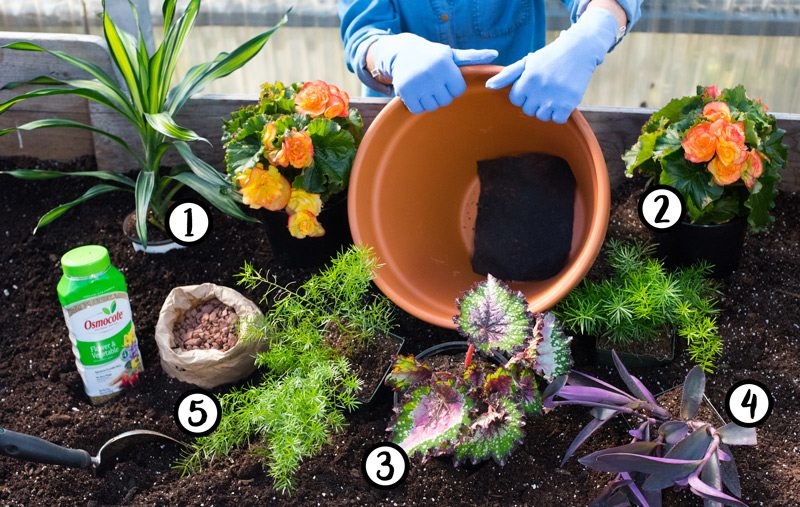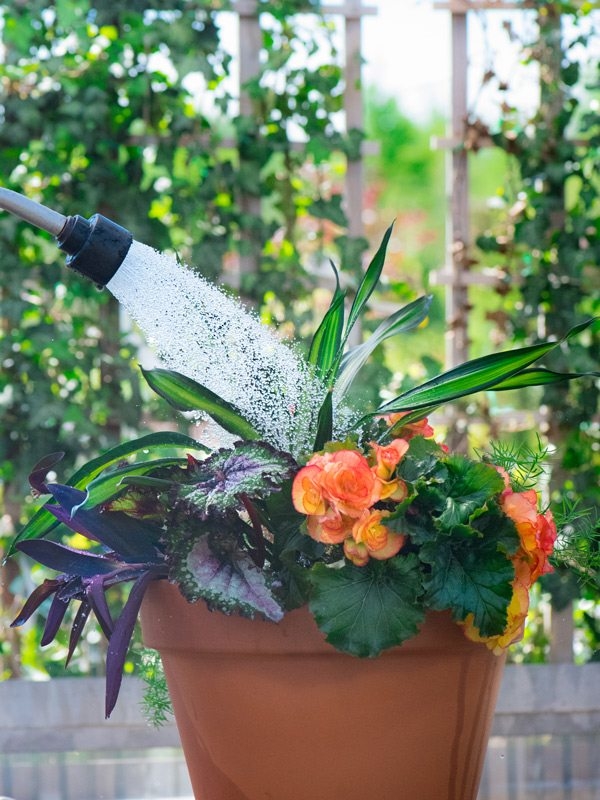Creating a Custom Container Garden
Container gardening can add ambiance to your backyard patio, tie into the architecture of your home and welcome your guests at your entrance. It’s also ideal for small spaces. You can have all of the convenience of a yard right outside your front or back door.
I love incorporating container gardens throughout my garden to create focal points in my sitting areas. Here are the simple steps I follow to construct my containers that you can easily follow to create your own custom container garden.
Step one: Select your plants
The goal with any container planting is to have the perfect combination of plants to thrill, spill and fill:
- Thrill plants draw your eye into the container, creating a focal point through height, color, bloom or texture.
- Spill plants draw your eye down and through the container by trailing over the edge.
- Fill plants are those that help to fill the voids in the pot. They typically provide contrast to your thrill plant and add interest.
You can collect these plants from all different areas of the nursery. We love combining traditional blooming and foliaged annuals with perennials and petite shrubs for a unique combination. Plus, when you incorporate perennials and shrubs, you have the added benefit of having your container garden morph with you into future seasons where you can simply replace the faded annuals with cool season annuals when the weather changes.
We selected:
- Variegated dracaena for our thrill
- Setcreasea ‘Purple Heart’, jurassic purple begonia, and begonia hiemals as our fill
- Airy asparagus fern as our spill
For our 14” container we selected a total of seven plants to fill the space, but not overcrowd.
- Variegated dracaena 2. Begonia hiemals 3. Jurassic purple begonia 4. Setcreasea ‘Purple Heart’ 5. Asparagus fern
Step two: Select your materials
Once you have your plants selected, choose a container that compliments the blooms and foliage. You want to choose a vessel that will allow your plants to pop! When selecting a container, make sure it has a hole in the bottom for drainage. Here are a few other supplies you’ll need to get started:
- Small square of landscape fabric: You’ll place this over the drainage hole in the bottom of the pot to prevent the soil from escaping the bottom (and the critters from coming up into the pot).
- Potting soil: Potting soil is nice and lightweight, making it easy to work with in a container setting. We recommend using our Merrifield Potting Mix. For our 14” pot we’ll need two, 16 qt. bags.
- Fertilizer: To keep your blooms ongoing throughout the season, we recommend using fertilizer at the time of planting. You can use an organic option such as Espoma Plant Tone, or an inorganic, slow release granular, such as our Merrifield Flowering Plant Food or Osmocote.
- River jack stones or seminole chips to cover the top of the container surface: Squirrels love to burry in fresh soil, using small river jack stones or seminole chip will keep them out of your fresh plants. And, using either as a topper helps prevent the dirt from washing over the edge of the container when watering.
- Hand shovel for scooping up the potting mix
- Gardening gloves
Step three: Assemble your container
- Since your container can be heavy once its filled with the soil and plants, it’s best to set the container into place before you plant.
- Place your piece of landscape fabric over the drainage hole in the bottom of the pot.
- Fill your container 2/3 of the way with potting soil.
- Add your granular fertilizer to the potting soil and mix with your hand shovel. Be sure to follow the instructions on the label to determine the appropriate amount of fertilizer to mix in.
- Place your plants into your container and adjust to alternate the color and texture until you balance out the interest throughout the pot. For a container that needs interest from all angles, place the thrill in the middle. If you’re designing a container for a corner area, you can place the thrill in the back of the pot and work down toward your spill plants in the foreground.
- Top off the container with soil, but keep it an inch from the top of the container.
- Cover the surface of the soil with a half-of-an-inch of small river jacks or seminole chips.
Step four: Care for your container garden
Once your container garden is set, water it thoroughly using a watering wand and garden hose. Run the water over your container, letting it drain out of the bottom. How frequently your container garden will need water depends on the size of the container, plant mix and placement (full sun containers will dry out more quickly than shade containers). Check your container for water every few days to ensure that it does not dry out. As the weather warms you may need to check it more frequently.
To keep your blooms looking their best all season, we recommend using a water-soluble fertilizer, such as Jack’s Classic Blossom Booster. I like to use a half strength dosage every other week when watering.




